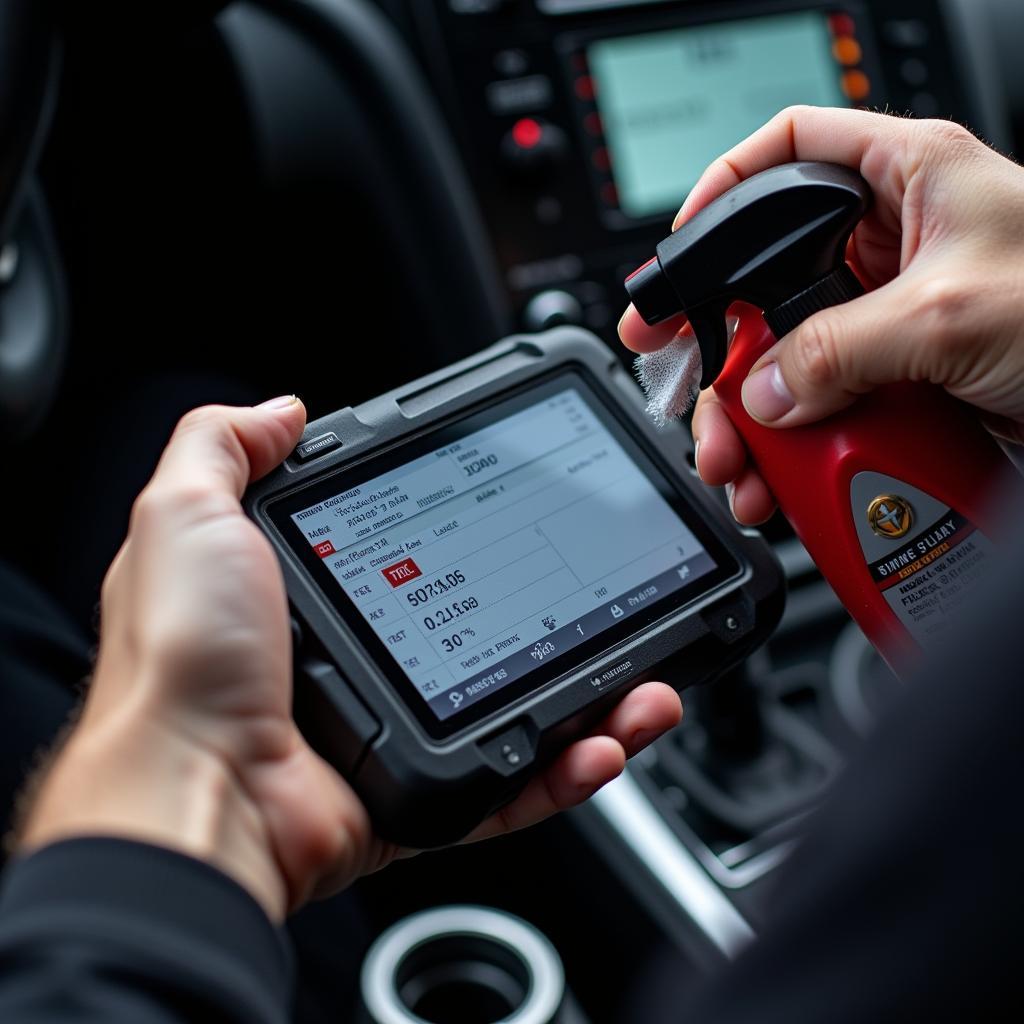Proper Care And Maintenance Of Tools And Equipment are crucial for any professional, especially in the automotive industry. Neglecting your tools can lead to inaccurate diagnostics, costly repairs, and even safety hazards. This comprehensive guide will delve into the best practices for maintaining your car diagnostic tools and other equipment, ensuring they remain reliable and accurate for years to come.
Why is Proper Tool Maintenance Important?
Maintaining your tools goes beyond just keeping them clean. It directly impacts the quality of your work, the longevity of your equipment, and your overall safety. A well-maintained diagnostic tool, for instance, provides accurate readings, allowing you to pinpoint issues quickly and efficiently. This saves you time and money in the long run. Furthermore, regular maintenance prevents premature wear and tear, extending the lifespan of your valuable investments.
 Diagnostic Tool Maintenance
Diagnostic Tool Maintenance
Essential Maintenance Practices for Car Diagnostic Tools
Car diagnostic tools, like any other sophisticated equipment, require specific care. Here are some key practices to follow:
- Regular Cleaning: Dust, grime, and oil can interfere with the proper functioning of your diagnostic tools. Regularly clean them using appropriate cleaning solutions and soft cloths. Avoid using abrasive materials that could scratch or damage the surfaces.
- Software Updates: Keep your diagnostic software up-to-date. Manufacturers frequently release updates that improve functionality, fix bugs, and add compatibility with newer vehicle models.
- Proper Storage: Store your diagnostic tools in a clean, dry environment, away from extreme temperatures and humidity. Use protective cases to prevent damage during transport.
- Battery Care: If your diagnostic tool uses a rechargeable battery, ensure it’s charged correctly and avoid overcharging or deep discharging. Replace the battery when it no longer holds a charge effectively.
- Calibration: Some diagnostic tools require periodic calibration to maintain accuracy. Refer to the manufacturer’s instructions for specific calibration procedures.
 Car Diagnostic Tool Storage
Car Diagnostic Tool Storage
Maintaining Other Essential Automotive Tools
Beyond diagnostic tools, proper maintenance is essential for all automotive tools. Whether it’s car working tools or the best tools for changing a car tire, regular care ensures their effectiveness and longevity.
Hand Tools
- Cleaning and Lubrication: Clean hand tools after each use to remove dirt and debris. Lubricate moving parts to prevent rust and ensure smooth operation.
- Sharpening: Regularly sharpen cutting tools like knives and shears to maintain their effectiveness.
- Inspection: Inspect hand tools for any signs of damage, such as cracks or chips. Replace damaged tools immediately.
Power Tools
- Air Tool Maintenance: If you use pneumatic tools, ensure they are properly lubricated and that the air supply is clean and dry.
- Electrical Safety: Inspect power cords for damage and replace them if necessary. Always disconnect power tools before performing any maintenance.
- Proper Storage: Store power tools in a dry location, away from moisture and extreme temperatures.
 Power Tool Maintenance
Power Tool Maintenance
How Often Should You Maintain Your Tools?
The frequency of maintenance depends on the type of tool and how often it’s used. As a general rule, inspect your tools regularly and perform necessary maintenance tasks as needed. For frequently used tools, a weekly cleaning and inspection are recommended. For less frequently used tools, monthly maintenance may suffice. Always consult the manufacturer’s instructions for specific recommendations.
What are the Consequences of Neglecting Tool Maintenance?
Neglecting tool maintenance can lead to several undesirable consequences:
- Inaccurate Readings: Dirty or malfunctioning diagnostic tools can provide inaccurate readings, leading to misdiagnosis and unnecessary repairs.
- Tool Failure: Lack of maintenance can cause tools to fail prematurely, requiring costly replacements.
- Safety Hazards: Damaged or poorly maintained tools can pose a safety risk to both the user and the vehicle.
Conclusion
Proper care and maintenance of tools and equipment are essential for any automotive professional. By following the guidelines outlined in this article, you can ensure the longevity, accuracy, and safety of your tools, enabling you to perform your work efficiently and effectively. Remember, investing in proper tool maintenance is an investment in your career and the success of your business.
FAQ
- What cleaning solutions are safe for car diagnostic tools?
- How often should I update my diagnostic software?
- What are the signs of a failing car battery in a diagnostic tool?
- How do I know if my diagnostic tool needs calibration?
- What are the essential tools for changing a car tire?
- How can I prevent rust on my hand tools?
- What safety precautions should I take when using power tools?
For any assistance, feel free to contact us via WhatsApp: +1(641)206-8880, Email: [email protected] or visit our office at 910 Cedar Lane, Chicago, IL 60605, USA. We have a 24/7 customer support team available to help you.

Leave a Reply